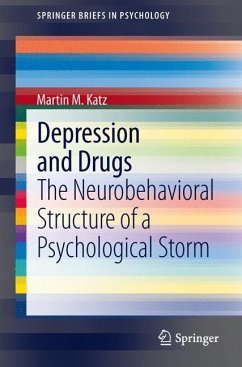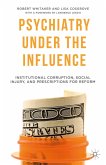This book integrates the current state of knowledge on the association of neurochemical and psychological factors underlying the concept of depression or on the process and nature of the drug-induced changes that lead to recovery. Highlighting the results of two major multisite collaborative studies of the psychobiology of depression, the author demonstrates how more refined clinical methods uncover the initial behavioral actions of the drugs and chart the time course of their actions. The results disconfirm earlier textbook reported findings that these actions are delayed for several weeks beyond the almost immediate neurochemical effects. The "multivantaged" method makes possible distinguishing the clinical actions of different classes of antidepressant drugs.
"Dr. Katz's career was completely contemporaneous with the introduction of imipramine into psychiatry and was actively involved with most aspects of studies in the area of depression and its treatment and evaluation,. He was a primary player in the United States National Institute of Mental Health (NIMH) Collaborative Psychobiology of Depression Program launched in 1970 and ran for 10 years. He was involved in very many of the NIMH and United States Veterans Administration (VA) collaborative studies in these areas. This background together with his own research on the clinical assessment concerns about the methods and the approaches used for the evaluation of change caused him considerable concern. He then undertook methods to develop new approaches that might present an evaluation of different facets of the clinical state. From his position he was perfectly situated to look at the data from all points of the compass, His conclusions offer the reader a very sobering picture of our current status of knowledge and he concludes we need to reevaluate our many positions and beliefs. He quotes a Collegium Internatinale Neuro-Psychopharmacologicum (CINP) task force report "we still have found no biological 'markers' of the disorder nor are we completely clear as to mechanisms underlying their efficacy in depression" or their mode of action. He goes on to note the vast disparity in accumulated knowledge in genetics and neurosciences with the fact that no new compounds have been developed in the last 30 odd years. He feels that part of the problem may be in the central clinical problems in this area as well as the design and assessment aspects of the study He has spent many years of his own research in trying to address these questions. In conclusion the volume forces us to look at these discrepancies with these new approaches in mind."
Samuel Gershon
Professor at University of Miami, Department of Psychiatry
August 15,2013
"We all have to listen carefully when a psychologist has released a book on the treatment of depression with drugs. Even more so when the psychologist is Martin Katz who was executive secretary of the first advisory committee to Jonathan Cole's Psychopharmacology Service Centre in the USA in the late 1950s, and was director of the Laboratory of Experimental Psychology in Herman van Praag's Department of Psychiatry at Albert Einstein University in New York in the early 1990s.
The neurobehavioral approach to depression is described in this small and well-written book in which Martin Katz links the functioning of the serotonergic and noradrenergic neurotransmitter systems in the brain to different clinical components of depressive states. Katz's story is in a certain sense the opposite story to Arvid Carlsson's when identifying the functioning of these neurotransmitter systems. Carlsson was inspired by the work of the experienced psychiatrist, Paul Kielholz who found clomipramine to be the most potent mood activating tricyclic antidepressant and desipramine to be the most motor activating tricyclic antidepressant. Building on Kielholz's clinical findings Carlsson showed that the dual actions of these antidepressant drugs entailed an initial effect on serotonin reuptake inhibition and thereafter an effect on noradrenaline reuptake inhibition. Had Carlsson accepted the claims in many reviews that all antidepressants have the same therapeutic profile he would not have been able to discover what he did. In the same way, had Martin Katz followed meta-analytic findings he would not have discovered that the profile of clinical depression is a psychological storm, a state of psychological turmoil, a term he borrowed from William Styron's description of his own depressive illness in his book, Darkness Visible. Using principal component analysis in clinical trials with both the Hamilton Depression Scale and the self-reported SymptomChecklist (SCL-90) Katz and his co-authors identified three components explaining 75% of the variance. The three components are: depressed mood, anxiety-arousal symptoms, including sleep, and hostility - interpersonal sensitivity.
Using these three components Katz compared the serotonin reuptake inhibitor paroxetine and the noradrenaline (norepinephrine) reuptake inhibitor desipramine in a placebo-controlled study. In patients who had a good clinical response it was possible to show within the first two weeks of therapy that drugs acting on serotonin reuptake have an effect on anxiety as well as on hostility some days before their action on noradrenaline and depression.
On the basis of his findings Katz's recommendation to the industry is that clinical trials with new potential antidepressant need not last more than two weeks, and that the classical practice of relying only on the total score on the Hamilton Depression Scale might result in the throwing out of many good babies, good drugs, with the bathwater.
In 1994 Martin Katz asked in a paper whether we are doing the right thing when we are using the traditional meta-analytic studies with the total Hamilton score as outcome measure in clinical trials with antidepressants. Over the last two decades Katz has confirmed that using the total Hamilton score is wrong. His small book tells us how to perform clinical trials with antidepressants. All those who are searching to find new antidepressants with a more rapid mode of action than the ones in clinical use need to read his book - listen to the words of the wise."
Per Bech, author, leader in Psychometics
University of Copenhagen
September 19, 2013
Samuel Gershon
Professor at University of Miami, Department of Psychiatry
August 15,2013
"We all have to listen carefully when a psychologist has released a book on the treatment of depression with drugs. Even more so when the psychologist is Martin Katz who was executive secretary of the first advisory committee to Jonathan Cole's Psychopharmacology Service Centre in the USA in the late 1950s, and was director of the Laboratory of Experimental Psychology in Herman van Praag's Department of Psychiatry at Albert Einstein University in New York in the early 1990s.
The neurobehavioral approach to depression is described in this small and well-written book in which Martin Katz links the functioning of the serotonergic and noradrenergic neurotransmitter systems in the brain to different clinical components of depressive states. Katz's story is in a certain sense the opposite story to Arvid Carlsson's when identifying the functioning of these neurotransmitter systems. Carlsson was inspired by the work of the experienced psychiatrist, Paul Kielholz who found clomipramine to be the most potent mood activating tricyclic antidepressant and desipramine to be the most motor activating tricyclic antidepressant. Building on Kielholz's clinical findings Carlsson showed that the dual actions of these antidepressant drugs entailed an initial effect on serotonin reuptake inhibition and thereafter an effect on noradrenaline reuptake inhibition. Had Carlsson accepted the claims in many reviews that all antidepressants have the same therapeutic profile he would not have been able to discover what he did. In the same way, had Martin Katz followed meta-analytic findings he would not have discovered that the profile of clinical depression is a psychological storm, a state of psychological turmoil, a term he borrowed from William Styron's description of his own depressive illness in his book, Darkness Visible. Using principal component analysis in clinical trials with both the Hamilton Depression Scale and the self-reported SymptomChecklist (SCL-90) Katz and his co-authors identified three components explaining 75% of the variance. The three components are: depressed mood, anxiety-arousal symptoms, including sleep, and hostility - interpersonal sensitivity.
Using these three components Katz compared the serotonin reuptake inhibitor paroxetine and the noradrenaline (norepinephrine) reuptake inhibitor desipramine in a placebo-controlled study. In patients who had a good clinical response it was possible to show within the first two weeks of therapy that drugs acting on serotonin reuptake have an effect on anxiety as well as on hostility some days before their action on noradrenaline and depression.
On the basis of his findings Katz's recommendation to the industry is that clinical trials with new potential antidepressant need not last more than two weeks, and that the classical practice of relying only on the total score on the Hamilton Depression Scale might result in the throwing out of many good babies, good drugs, with the bathwater.
In 1994 Martin Katz asked in a paper whether we are doing the right thing when we are using the traditional meta-analytic studies with the total Hamilton score as outcome measure in clinical trials with antidepressants. Over the last two decades Katz has confirmed that using the total Hamilton score is wrong. His small book tells us how to perform clinical trials with antidepressants. All those who are searching to find new antidepressants with a more rapid mode of action than the ones in clinical use need to read his book - listen to the words of the wise."
Per Bech, author, leader in Psychometics
University of Copenhagen
September 19, 2013








